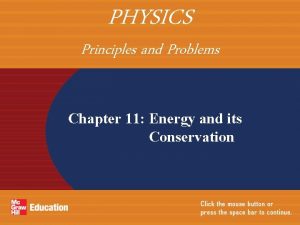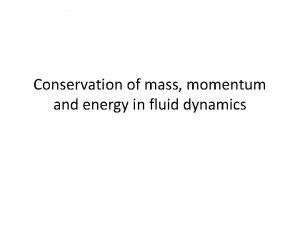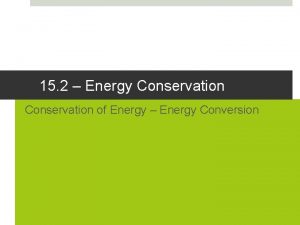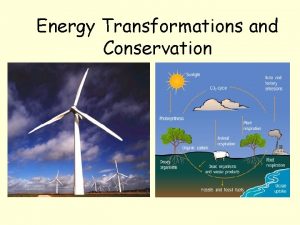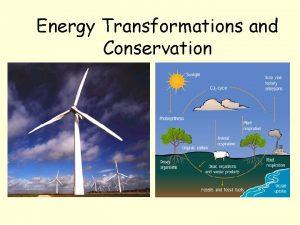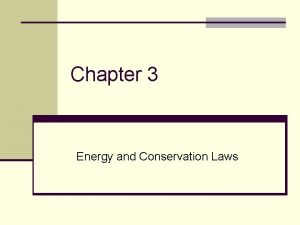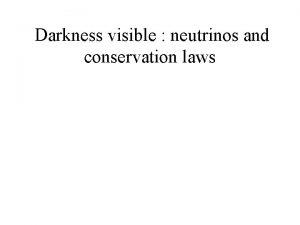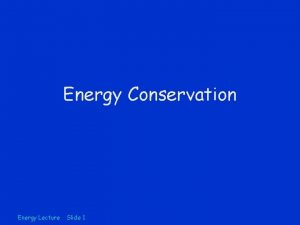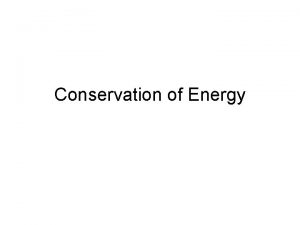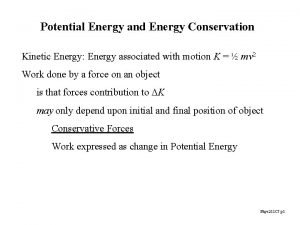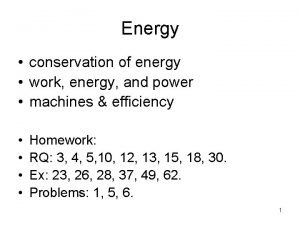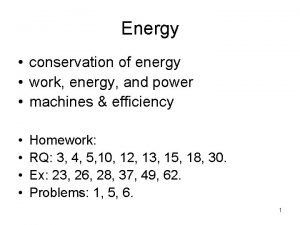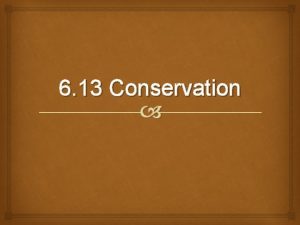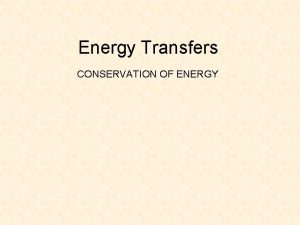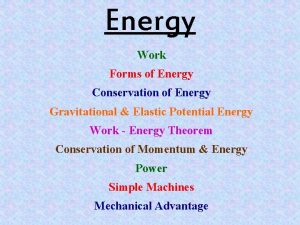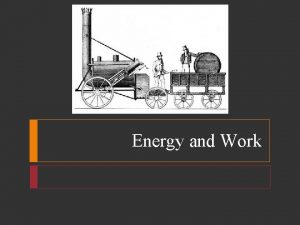Conservation Laws Work and Conservation of Energy WORK













- Slides: 13

Conservation Laws Work and Conservation of Energy

WORK OF CONSERVATIVE FORCES Conservative Forces Environment The force of gravity, Fg , and the restoring force, FS , are conservative forces. Object / System When these forces act, energy is conserved in the object or system under investigation. Ug K US Conservative Forces Act Forces from the environment (objects or systems outside of those under investigation) are not involved. Example: A ball dropped from a height h loses gravitational potential energy. If there is no environmental interference, such as air resistance, the resulting kinetic energy will have the same magnitude as the potential energy that was lost. Force gravity is a conservative force.

WORK OF NON-CONSERVATIVE FORCES Environment Non-conservative Forces Applied forces, F , and friction, f , are examples of non-conservative forces. When these forces act, energy enters or leaves the system as the work of non-conservative forces. Energy in the system is no longer conserved. However, energy in the universe remains the same. Energy gained/lost by the object/system is lost/gained by the environment. Object / System K +W −W Ug US Conservative Forces Act Non-Conservative Forces Act Example: When an object with kinetic energy encounters a rough surface the work of friction, Wf , drains energy from the system. The lost energy transfers to the environment. The surface becomes warmer.

Example 1 N f m Fg Initial h 0 = 0 x 0 = 0 (no spring) v 0 = 4. 0 m/s A 2. 0 kg mass is initially moving at 4. 0 m/s along a rough horizontal surface, with μk = 0. 20. How far will the object travel before coming to a stop? v N m d=? Fg Any non-conservative force ? Rough surface: Friction d=? Final h 0 = 0 x 0 = 0 (no spring) v 0 = 0 m/s

CONSERVATION OF ENERGY REVISITED Use the overall concept equation as a guide to building a custome equation Select from the above menu of available energies to build your equations.

Example 2 A ball is thrown upward from the ground. How high will it go? Initial Conditions? Starts at lowest point, h 0 = 0 No spring, x 0 = 0 To move upward there must be an initial velocity, v 0 Non-conservative forces? None mentioned Final Conditions? Reaches maximum height, h Still no spring, x = 0 At max height objects have an instantaneous zero velocity, v 0

Example 3 A toy gun consists of a spring in a tube. The compressed spring launches a ball horizontally. Determine the ball’s speed when it exists the tube. Initial Conditions? Starts at lowest point, h 0 = 0 The spring is compressed, x 0 Initially at rest, v 0 = 0 Non-conservative forces? None mentioned Final Conditions? Moves horizontally, h = 0 Spring restored, x = 0 Ball is now moving, v

Example 4 A mass initially at rest slides down a rough incline. Determine the speed of the mass after sliding a distance, Δr , measured along the incline. Initial Conditions? Starts at top of incline, h 0 No spring, x 0 = 0 Initially at rest, v 0 = 0 Non-conservative forces? Friction on an incline Final Conditions? Reaches lowest point, h = 0 No spring, x = 0 Determine speed, v Be careful. Students solving for the work of friction often focus on getting the force of friction correct, and as a result they forget to include the displacement, d.

Example 5 A 2. 0 kg mass starts from rest at the top of a smooth, frictionless, quarter circle of R = 3. 0 m. When it reaches the bottom of the curve it moves along a horizontal section of track that is rough, μk = 0. 50. Determine the horizontal displacement, d , of the mass before coming to rest. This above equation is a generic equation using standard variables. Adapt the variables to fit the problem being solved. R d

Example 6 A 0. 50 kg mass starts from rest at the top of a smooth, frictionless, quarter circle of R = 1. 5 m. When it reaches the bottom of the curve the mass travels 2. 0 m on a rough horizontal section, μ = 0. 35. At the end of the track there is a 0. 80 m drop. Determine the horizontal displacement x , during the drop. R This is actually two separate problems 1 st solve the energy problem to find the speed that it has at the end of the horizontal rough surface. v 2. 0 m Then solve for a horizontally launched projectile. 0. 80 m x=?

Example 6 A 0. 50 kg mass starts from rest at the top of a smooth, frictionless, quarter circle of R = 1. 5 m. When it reaches the bottom of the curve the mass travels 2. 0 m on a rough horizontal section, μ = 0. 35. At the end of the track there is a 0. 80 m drop. Determine the horizontal displacement x , during the drop. R Adapt the variables to fit the problem v 2. 0 m

Example 6 A 0. 50 kg mass starts from rest at the top of a smooth, frictionless, quarter circle of R = 1. 5 m. When it reaches the bottom of the curve the mass travels 2. 0 m on a rough horizontal section, μ = 0. 35. At the end of the track there is a 0. 80 m drop. Determine the horizontal displacement x , during the drop. v 0. 80 m x=? Horizontally launched projectile Use speed found using conservation of energy

Example 7 A 5. 0 kg mass initially at rest slides down a smooth, frictionless, quarter circle of R = 4. 0 m. Then the mass moves 3. 0 m on a rough horizontal section of track, μk = 0. 10. Finally the mass compresses a spring with a spring constant of k = 20 N/m. Determine maximum compression of the spring. Adapt the variables to fit the problem R 3. 0 m
 Chapter 7 energy conservation of energy
Chapter 7 energy conservation of energy Charles de secondat
Charles de secondat Section 4 review physical science
Section 4 review physical science Energy energy transfer and general energy analysis
Energy energy transfer and general energy analysis Energy energy transfer and general energy analysis
Energy energy transfer and general energy analysis Work and energy section 2 describing energy answer key
Work and energy section 2 describing energy answer key Physics 03-01 work and the work-energy theorem
Physics 03-01 work and the work-energy theorem Chapter 11 study guide energy and its conservation
Chapter 11 study guide energy and its conservation Mass momentum and energy conservation
Mass momentum and energy conservation Chapter 11 energy and its conservation answers
Chapter 11 energy and its conservation answers Energy conversion and conservation
Energy conversion and conservation Conservation of mass momentum and energy equations
Conservation of mass momentum and energy equations Single transformation of energy
Single transformation of energy Energy transformations and conservation
Energy transformations and conservation







